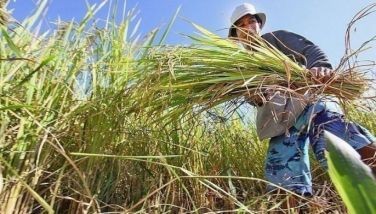Plant growth enhancer from waste coco water developed
June 20, 2004 | 12:00am
And now, a plant growth enhancer from waste coconut water.
Named ‘Cocogro,’ the product was developed by researchers led by Dr. Juanita C. Mamaril under the aegis of the University of the Philippines Los Baños-National Institute of Molecular Biology and Biotechnology (UPLB-Biotech). Among those also involved in the research were Dr. Lorelei Trinidad and Estela Paner.
It was subsequently refined and its production scaled up through the support of the Los Baños-based Philippine Council for Agriculture, Forestry and Natural Resources Research and Development (PCARRD) and Philippine Council for Advanced Science and Technology Research and Development (PCASTRD), both agencies of the Department of Science and Technology (DOST).
Cocogro is now available at UPLB-Biotech in 250 milliliters, 500 ml, and one liter.
The product, as explained by Dr. Mamaril (now retired), is not a fertilizer substitute but an alternative to imported and synthetic plant growth hormones.
The technology has been issued a patent by the Documentation, Information, and Technology Transfer Bureau of the Intellectual Property Office under the Office of the President.
UPLB-Biotech, currently headed by Director Teresita Espino, noted that coconut water is usually thrown away in copra production.
Such practice means big waste, it pointed out, considering that coconut water contains a variety of fine biochemicals, including plant growth hormones such as gibberilllins, cytokinins, asnd auxins.
The technology developed by Dr. Mamaril’s team processes the coconut water by filtering and extracting the plant growth hormones. The end-product is a natural, safe, and environment-friendly plant growth enhancer.
UPLB-Biotech pointed out that the application of Cocogro can increase the vitality and germination of seeds, induce root formation, and enable more efficient nutrient uptake, which subsequently results in vigorous, rapid plant growth and increase in yield. It also promotes flowering and increases drought resistance owing to increased water retention of the roots.
PCARRD’s Jesselle Solivas further reported that Cocogro is either sprayed on plants or used as a soaking medium. The amount and method of applying Cocogro depends on the type of plants grown. Cocogro can also be used in ornamentals, cereal crops, fruit trees, and other flowering plants. The quality of ‘tinapa’ (smoked fish) can be improved by using agricultural wastes such as rice hull and bagasse in smoking it.
The production cost of the process is also much lower, said Myrna Bigueja and Marietta Mabana, fisheries researchers of the Partido State University in Goa, Camarines Sur.
The researchers presented a report on their study at the First Regional Research, Development and Extension Symposia for Fisheries of the Philippine Council for Aquatic and Marine Research and Development-Southern Luzon Aquatic Resources R&D Network (PCAMRD-SLARRDM) held not long ago at the Bicol University-Tabaco campus.
Bigueja and Mabana noted that of the different flavor enhancers they used for smoking Indian mackerel, known as ‘burso’ in the Bicol region, bagasse (a by-product of sugar mills) gave the best taste, color, and odor for the product.
They also tested the smoke flavor-enhancing qualities of lemon grass, pomelo and guava leaves using rice hull as the source of smoke. They used one kilo of each flavor enhancer for every five kilos of processed fish that was also smoked at 80-100 degrees Celsius for three hours.
"In the absence of bagasse, use of rice hull only for smoking will give acceptable results," the researchers said.
They added that use of rice hull and bagasse in areas where they are abundant can lower the operating cost of small-scale fish processors.
"For an operation of 150 kilos of fresh fish for smoking per day, a processor can have an average net of P108,231 in six months, or a return on investment of 65 percent and payback of two months," Bigueja and Mabana concluded.
By now, many Filipinos must be familiar with ‘cornick’ or ‘chichacorn,’ a corn snack made of glutinous corn that is already marketed nationwide and even abroad.
In fact, a once small-time businesswoman in the Ilocos who ventured into chichacorn production is now a big-time entrepreneur.
Clemencia Padre, owner of the ‘Ilocos Food Products,’ coined the term chichacorn because it connotes a crunchy and crispy sound produced while ‘cornick’ is being eaten.
When she joined a Department of Trade and Industry (DTI)-sponsored trade fair in La Union, her chichacorn sold like the proverbial hotcake, recalled the ILARRDEC Reporter, a publication of the Ilocos Agriculture and Resources Research and Development Consortium.
Later, she began supplying groceries in La Union, Pangasinan, and Ilocos Sur. She also joined national trade fairs in Manila and Cebu.
Now, chichacorn is a natural hit.
To sustain the new industry, the research community has also been contributing its share.
Recently, for instance, the Mariano Marcos State University (MMSU) identified five cultivars of glutinous corn suitable for both the production of green corn and processing of grains into cornick.
These are IES Glutinous 1, IES Glutinous 5, MMSU Collection 1, MMSU Collection 2, and IPB Lagkitan.
PCARRD reported that a one-hectare green corn farm can yield a net income of P29,478, with an investment of P28,025.
It added: If corn is sold as grains for chichacorn production, one could earn P22,455 per hectare. If processed and sold as cornick net proceeds of P164,282 could be realized. Processing cost amounts to P38,177. — RAF
Named ‘Cocogro,’ the product was developed by researchers led by Dr. Juanita C. Mamaril under the aegis of the University of the Philippines Los Baños-National Institute of Molecular Biology and Biotechnology (UPLB-Biotech). Among those also involved in the research were Dr. Lorelei Trinidad and Estela Paner.
It was subsequently refined and its production scaled up through the support of the Los Baños-based Philippine Council for Agriculture, Forestry and Natural Resources Research and Development (PCARRD) and Philippine Council for Advanced Science and Technology Research and Development (PCASTRD), both agencies of the Department of Science and Technology (DOST).
Cocogro is now available at UPLB-Biotech in 250 milliliters, 500 ml, and one liter.
The product, as explained by Dr. Mamaril (now retired), is not a fertilizer substitute but an alternative to imported and synthetic plant growth hormones.
The technology has been issued a patent by the Documentation, Information, and Technology Transfer Bureau of the Intellectual Property Office under the Office of the President.
UPLB-Biotech, currently headed by Director Teresita Espino, noted that coconut water is usually thrown away in copra production.
Such practice means big waste, it pointed out, considering that coconut water contains a variety of fine biochemicals, including plant growth hormones such as gibberilllins, cytokinins, asnd auxins.
The technology developed by Dr. Mamaril’s team processes the coconut water by filtering and extracting the plant growth hormones. The end-product is a natural, safe, and environment-friendly plant growth enhancer.
UPLB-Biotech pointed out that the application of Cocogro can increase the vitality and germination of seeds, induce root formation, and enable more efficient nutrient uptake, which subsequently results in vigorous, rapid plant growth and increase in yield. It also promotes flowering and increases drought resistance owing to increased water retention of the roots.
PCARRD’s Jesselle Solivas further reported that Cocogro is either sprayed on plants or used as a soaking medium. The amount and method of applying Cocogro depends on the type of plants grown. Cocogro can also be used in ornamentals, cereal crops, fruit trees, and other flowering plants. The quality of ‘tinapa’ (smoked fish) can be improved by using agricultural wastes such as rice hull and bagasse in smoking it.
The production cost of the process is also much lower, said Myrna Bigueja and Marietta Mabana, fisheries researchers of the Partido State University in Goa, Camarines Sur.
The researchers presented a report on their study at the First Regional Research, Development and Extension Symposia for Fisheries of the Philippine Council for Aquatic and Marine Research and Development-Southern Luzon Aquatic Resources R&D Network (PCAMRD-SLARRDM) held not long ago at the Bicol University-Tabaco campus.
Bigueja and Mabana noted that of the different flavor enhancers they used for smoking Indian mackerel, known as ‘burso’ in the Bicol region, bagasse (a by-product of sugar mills) gave the best taste, color, and odor for the product.
They also tested the smoke flavor-enhancing qualities of lemon grass, pomelo and guava leaves using rice hull as the source of smoke. They used one kilo of each flavor enhancer for every five kilos of processed fish that was also smoked at 80-100 degrees Celsius for three hours.
"In the absence of bagasse, use of rice hull only for smoking will give acceptable results," the researchers said.
They added that use of rice hull and bagasse in areas where they are abundant can lower the operating cost of small-scale fish processors.
"For an operation of 150 kilos of fresh fish for smoking per day, a processor can have an average net of P108,231 in six months, or a return on investment of 65 percent and payback of two months," Bigueja and Mabana concluded.
By now, many Filipinos must be familiar with ‘cornick’ or ‘chichacorn,’ a corn snack made of glutinous corn that is already marketed nationwide and even abroad.
In fact, a once small-time businesswoman in the Ilocos who ventured into chichacorn production is now a big-time entrepreneur.
Clemencia Padre, owner of the ‘Ilocos Food Products,’ coined the term chichacorn because it connotes a crunchy and crispy sound produced while ‘cornick’ is being eaten.
When she joined a Department of Trade and Industry (DTI)-sponsored trade fair in La Union, her chichacorn sold like the proverbial hotcake, recalled the ILARRDEC Reporter, a publication of the Ilocos Agriculture and Resources Research and Development Consortium.
Later, she began supplying groceries in La Union, Pangasinan, and Ilocos Sur. She also joined national trade fairs in Manila and Cebu.
Now, chichacorn is a natural hit.
To sustain the new industry, the research community has also been contributing its share.
Recently, for instance, the Mariano Marcos State University (MMSU) identified five cultivars of glutinous corn suitable for both the production of green corn and processing of grains into cornick.
These are IES Glutinous 1, IES Glutinous 5, MMSU Collection 1, MMSU Collection 2, and IPB Lagkitan.
PCARRD reported that a one-hectare green corn farm can yield a net income of P29,478, with an investment of P28,025.
It added: If corn is sold as grains for chichacorn production, one could earn P22,455 per hectare. If processed and sold as cornick net proceeds of P164,282 could be realized. Processing cost amounts to P38,177. — RAF
BrandSpace Articles
<
>
- Latest
Latest
Latest
November 9, 2024 - 3:43pm
By E.H. Edejer | November 9, 2024 - 3:43pm
June 9, 2024 - 5:55pm
By Alberto Peña | June 9, 2024 - 5:55pm
May 24, 2024 - 10:00am
May 24, 2024 - 10:00am
May 14, 2024 - 3:43pm
By Ian Laqui | May 14, 2024 - 3:43pm
April 10, 2024 - 5:12pm
By Ian Laqui | April 10, 2024 - 5:12pm
Recommended



























